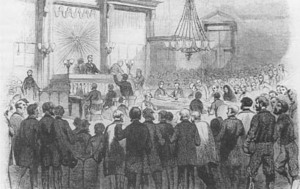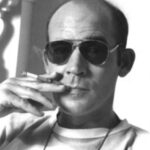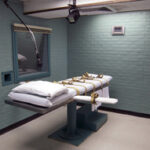From time to time, the media picks up on a particularly sensational trial in which they know the public will have an interest. While many people quickly grow tired of these trials, media outlets know that yellow journalism sells. We see it all the time today and it was no different in the 19th century. Long before Michael Jackson, Scott Petterson, and OJ Simpson made headlines, the murder trial of Emma Cunninham captivated the news media and readers all over the country.
George Cunningham died in New York City in 1852 leaving his widow, Emma Cunningham to take care of their five children. Although Emma and her children could have probably lived for some time on the proceeds of the $10,000 life insurance policy George left her, she was a relatively young, attractive widow who knew that she could quickly find another husband.
She soon met a wealthy dentist by the name of Dr. Harvey Burdell. The unmarried Burdell rented rooms in his mansions to various tenants, so Emma soon took up residence with him. The two of them may have had an illicit relationship, but it is unlikely that they were in love as Emma later claimed.
By most accounts, Burdell was not a very nice man. Although he was worth over $100,000 (a lot of money in his day), some claimed he had defaulted on debts and even embezelled money. There are even some who claim that he abused Emma and forced her to have two abortions against her will after getting her pregnant twice.
In early 1857, Burdell was murdered. Someone strangled him and stabbed him at least fifteen times in his own home. After examining his bloody corpse, the police concluded that his assailant had been left handed. It just so happened that Emma was left-handed. That fact, along with testimony from BurdellÕs servants saying that the two had engaged in an argument the night before led the police to suspect and arrest Emma.
While in prison awaiting trial, Emma claimed that her and Burdell had married in secret the previous year and that she was pregnant with his child. She even produced a marriage certificate as evidence. This revelation undermined the prosecutionÕs argument that Emma had hated Burdell. Why would she murder her husband and the father of her unborn child? She played up her great love for Burdell by throwing herself on his casket and creating quite a scene at his funeral.
The revelation also raised the stakes of the trial. If the jury concluded, as the prosecution asserted, that she had murdered Burdell because she was having an affair with another tenant of the mansion, than she would go to prison. If the jury believed that she was the unfortunate and unhappy widow, she would gain more than her freedom. She would inherit everything that the wealthy Burdell had owned. The media picked up the story and the trial became an instant sensation. As many as 8,000 people showed up at BurdellÕs funeral to get a glimpse of Emma and many more followed the trail in the papers with great interest.
As the trial drug on, onlookers noticed that EmmaÕs belly was growing as her pregnancy advanced. Her doctor told the prosecution that he believed she had a pillow or some similar device under her shirt, but he could not be sure as she refused to be examined. Understandably, she had no interest in being found out. Remarkably, the courts were powerless to demand that she be examined. Because the mores of Victorian society prevented a woman from being touched by any man other than her husband, she had a perfectly legitimate reason to refuse allowing the doctor to examine her. Further, those same mores prevented the prosecution or the court from demanding her to do so. As much as the prosecution may have thought she was faking a pregnancy, they had literally no way to prove it.
Because of this, she was acquitted and went free. That was not the end of the story, however. The prosecutor refused to give up. He had her house watched. Before long, the watch paid off when a nun was caught delivering a baby in a basket to Emma. Apparently, Emma had paid $1000 to adopt a child to complete the charade of her pregnancy. Having been found out, Emma withdrew her claims to BurdellÕs estate. She did not face further prosecution, however, as she could not be tried for same murder twice.
Emma was acquitted, but she had to give up the money. The prosecutor was right, but he could not do anything about it. BurdellÕs murder was never avenged and was never really solved. Emma may have killed him or she may have just been an opportunist who saw a chance to make an easy $100,000. It seems that the only person who really profited from the aftermath of the trial was the biological mother of the baby that Emma had tried to buy. The trial had been so popular that she was able to rent the baby to the PT Barnum Circus for $25 per week.






